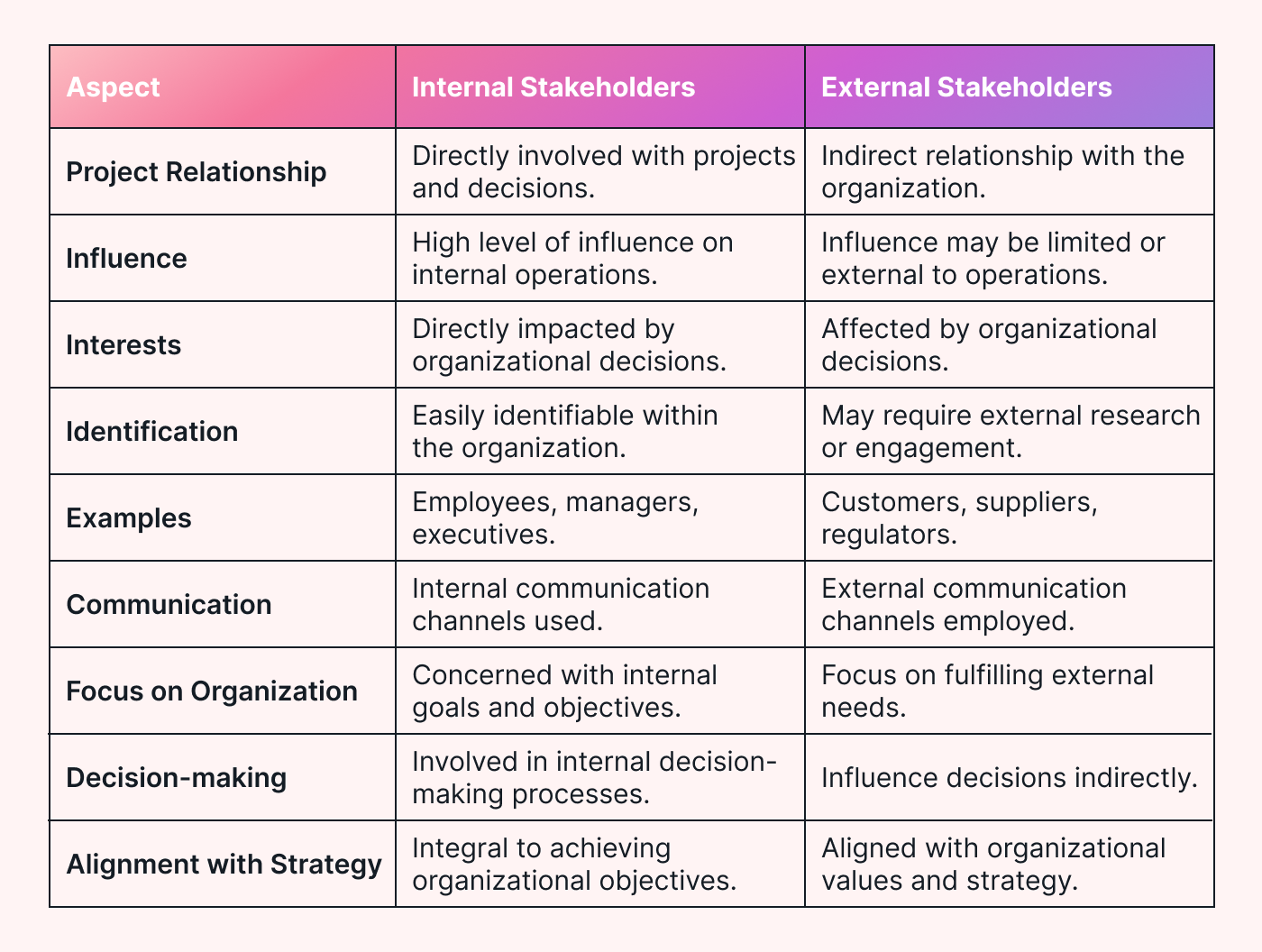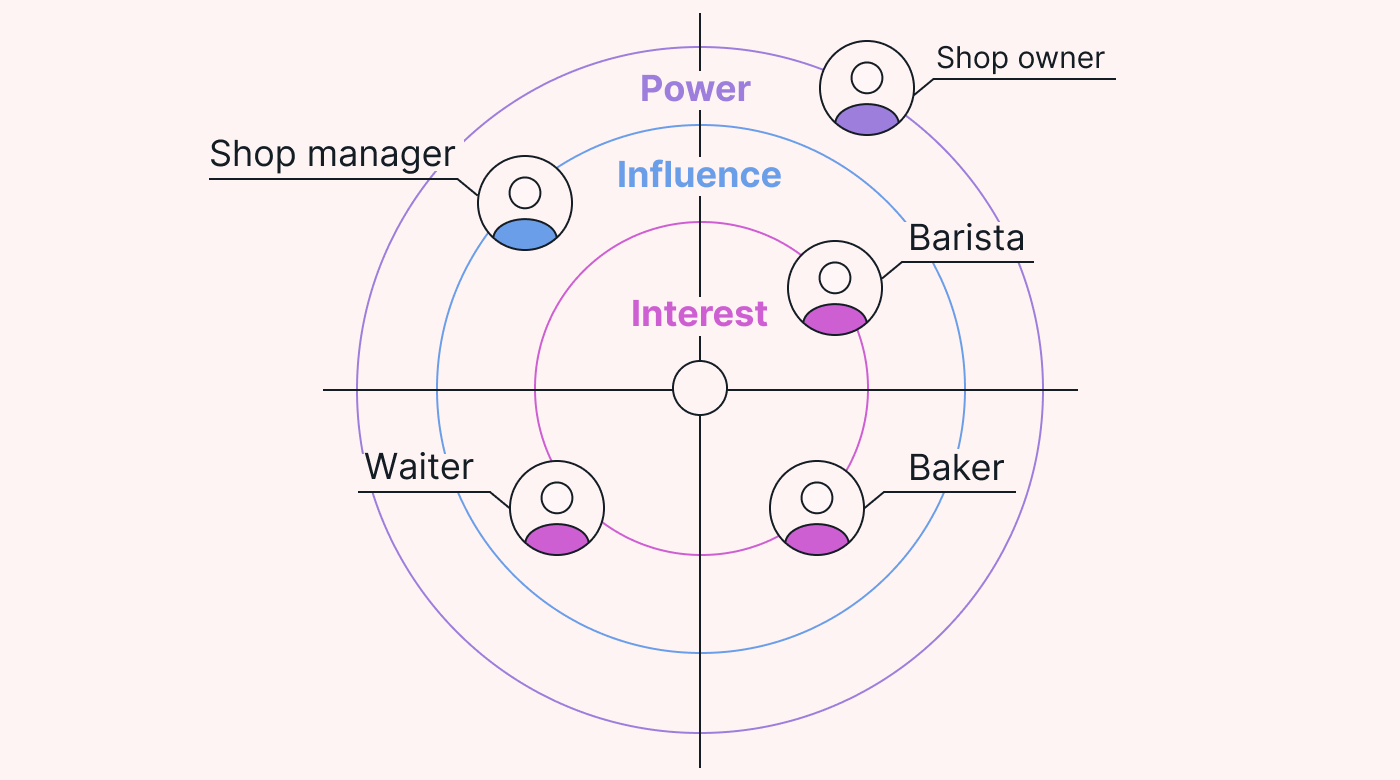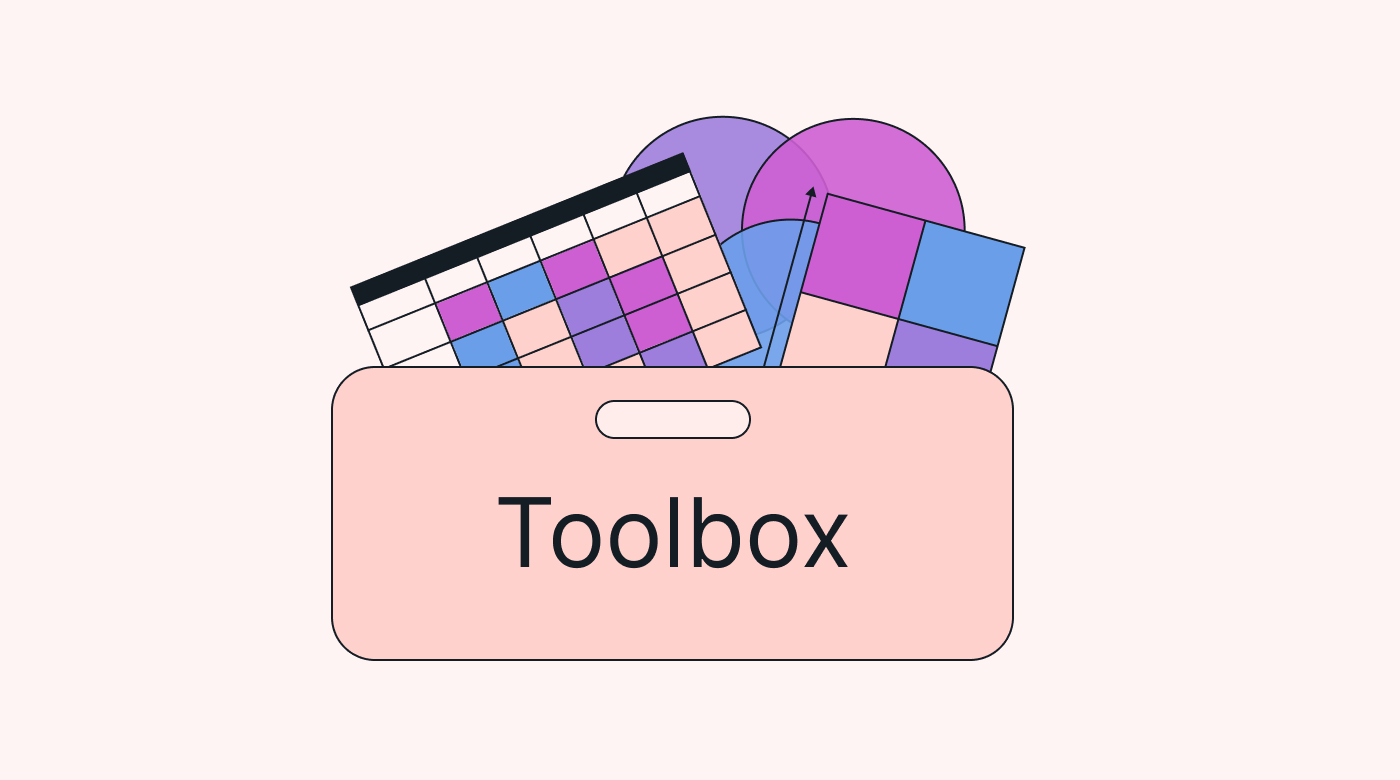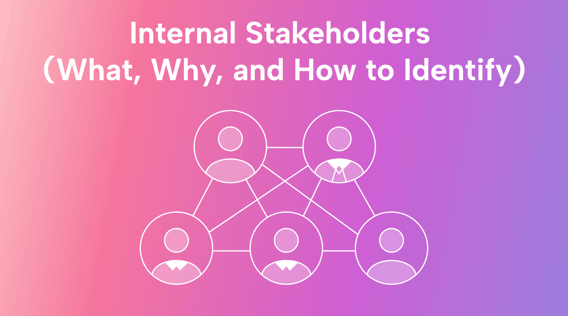Do you ever find yourself struggling to maintain a cohesive project environment? Are decisions taking too long and slowing down work?
Knowing who your internal stakeholders are and how to work with them can help you avoid these problems.
But what exactly are internal stakeholders? Why are they important? And how do you identify them?
In this article, we'll answer these three questions and show you a secret weapon for managing them.
What is a stakeholder?
A stakeholder is someone with a vested interest (stake) in the direction of a business or project. They can be external or internal to the business or project, and can come from any organizational level.
Key stakeholders often hold an influence over project outcomes; that’s why correctly managing them can lead to better project results.
What is an internal stakeholder?
Internal stakeholders come from within a business or project team.
Most of the time they have a direct interest in a project's success because they typically rely on the outcome of the goals or projects for their own gain.
The role internal stakeholders play within a project or in a business also directly translates into project performance. This influence can be due to their roles in the organization, their daily activities (work) or long-term strategic commitments.
For example, say we run a coffee shop.
The people who work in the coffee shop are the internal stakeholders, including the store manager, team leaders, and baristas. They make sure the coffee shop runs smoothly by providing:
- Top-quality customer service
- Great coffee
- Efficient day operations (so that busy patrons can get their coffee quickly and be on their way)
The most common levels of internal stakeholders include:
- Executives are the top-level decision-makers who steer the overall direction of the business. They have a substantial influence on strategic planning and resource allocation.
- Managers are mid-level decision-makers to senior management who oversee specific departments or teams.
- Frontline staff work in the business’s core operations, such as sales reps, product teams, and support personnel.
Stakeholders vs. shareholders
Let’s quickly distinguish internal stakeholders from shareholders.
Shareholders hold a financial stake in the business, such as owning shares or stocks. Internal stakeholders have an operational stake.
In the context of the coffee shop, shareholders are the people invested financially in the company’s goals. In contrast, internal stakeholders are vested in its performance beyond just financial ROI.
Internal stakeholder vs. external stakeholder
External stakeholders have a more indirect relationship with the project or business goals. These people or groups can be affected or affect the project's outcome, but they aren’t part of it.
 |
Examples of external stakeholders:
- Customers: of the products or services.
- Suppliers: of resources and materials.
- Government and regulatory bodies: can shut down or slow down work.
- Competitors: in the same market.
- Community and society: if the project impacts them.
- Financial institutions: like banks, lenders, and investors.
Why do you need to identify internal stakeholders?
Improved stakeholder engagement leads to higher project success rates and organizational growth. If you make stakeholders happy, your bottom line will thank you in the long run.
To show you, let’s go over two case studies:
1. VW
VW opted to stop sending emails after 6pm in 2011 to help their employees rest and switch off.
The result? A more focused, energized, and productive workforce during working hours. VW took the time to identify and look after their employees' needs.
2. Apple and Google
Apple and Google prove that taking care of your employees pays off. These giants both allocate tons of resources to help their workforces.
Apple invests heavily in employee training schemes. They also have a collaborative work atmosphere that nurtures creativity and high-level work.
Google’s flexible working hours and creative workspaces help their team feel relaxed. People who are more relaxed and less stressed put out higher quality work.
The results here? Satisfied employees delivering market-altering products.
How to identify and keep track of internal stakeholders
Using a stakeholder analysis, we can do both, identify and manage internal stakeholders.
A stakeholder analysis is used to gauge stakeholders' needs and expectations (and their potential impact on a project). It's also used to track and manage stakeholder expectations and needs throughout a project.
To do a stakeholder analysis, follow these steps:
1. Identify internal stakeholders
Compile a comprehensive roster of everyone from executives to frontline employees who has a hand in the project or has input on decisions.
Good sources for this information:
- A business organizational chart
- The company’s LinkedIn page
2. Assess stakeholder influence and interest
After you identify them, you assess their influence and interest in the project or decision-making process.
 |
To do this:
- Analyze their position, decision-making abilities, and influence over resources.
- Then, gauge the level of engagement or concern of each stakeholder in the project’s outcomes. Take into account their individual or career-related goals that could affect the success of the project.
- Rank each stakeholder and label them based on their influence and interest.
Two useful tools for labeling stakeholders are the Power-Interest Grid and the Influence-Interest Matrix. These tools generally categorize stakeholders into four groups:
- High influence and high interest
- High influence and low interest
- Low influence and high interest
- Low influence and low interest
Categorizing stakeholders like this helps you identify the most critical stakeholders.
3. Understand the stakeholder's expectations and needs
Next, you need to understand the internal stakeholders' needs. You can better strategize to meet these requirements if you know what they want from the business or project.
Surveys, focus groups, or one-on-one meetings are good ways to gather this information. Pay attention to their concerns and suggestions and pinpoint their specific needs during these sessions. You might have to dig deeper than the surface-level answers you get.
4. Create a stakeholder register
At this point, you can use the information you've gathered to compile a stakeholder register.
You'll want to make sure that you rank the stakeholders regarding their influence and interest.
Make sure to list the needs and requirements of your stakeholders and prioritize them regarding alignment with project and business goals.
Note that the stakeholder register is a living document. That's why you'll need to maintain it over time.
5. Maintain the stakeholder register
Stakeholder dynamics can change throughout a project lifecycle. This is why you need to regularly review and reassess your analysis.
To maintain the stakeholder register:
- Regularly review and update the stakeholder register at specific intervals, such as monthly or quarterly.
- Capture any new stakeholders who become involved in the project or decision-making processes promptly.
- Continuously track stakeholders' influence and interest levels and update their rankings accordingly.
- Keep track of stakeholders' evolving expectations and needs through surveys, meetings, or feedback sessions.
- Communicate significant changes in the stakeholder register to relevant project team members.
Tools and techniques to manage internal stakeholders
You’ve done all the hard work of identifying your internal stakeholders and creating a stakeholder register, but now what?
Now comes the part where you push your team and help them (and yourself) be successful. Here are some tools and techniques you can use.
Be a collaboration architect
How? Fosters a culture of communication and collaboration. Include internal stakeholders in the decision-making processes. Be a servant leader. Put the needs of internal stakeholders first.
Use a RACI
RACI is a tool that clarifies everyone's roles and responsibilities in a project. It's a great way to prevent confusion and conflicts.
With a RACI, stakeholders know: what tasks they need to work on (Responsible), who's answerable for project outcomes (Accountable), who needs to be consulted (Consulted) and who needs to be kept informed (Informed).
Note that an internal stakeholder can be categorized under multiple roles. For example, you might be responsible (the do'er) and accountable for a task.
Manage expectations
Proper expectation management aligns stakeholder expectations with realistic outcomes. It builds trust, reduces resistance to changes, and creates a positive project environment.
 |
You need to continuously inform stakeholders about project goals, timelines, and challenges to manage their expectations. Address concerns promptly, and always be transparent about progress and risks.
Use project management software
Project management software centralizes information and communication for project stakeholders. This way you can access stakeholder updates, tasks, and project-related information easily. Some also have features that complement stakeholder management.
Manage your internal stakeholders (automatically) with Motion
Motion can automate parts of the stakeholder management process by:
- Automatically booking essential meetings (it'll find the best time for participants).
- Allocating tasks to internal stakeholders.
- Keeping track of work and automatically rescheduling tasks when needed.
- Optimizing daily schedules.
Let Motion help you work with your internal stakeholders, not against them. At just $19 for a team plan, you can have everyone saving time and being more productive (a win-win).
Start your 7-day free trial.





